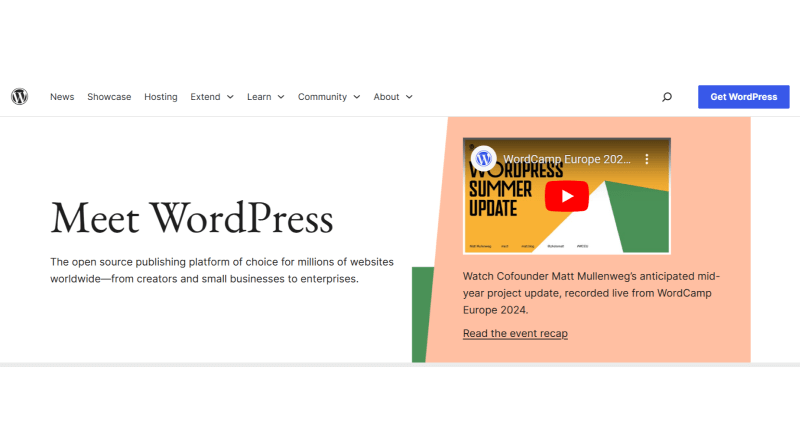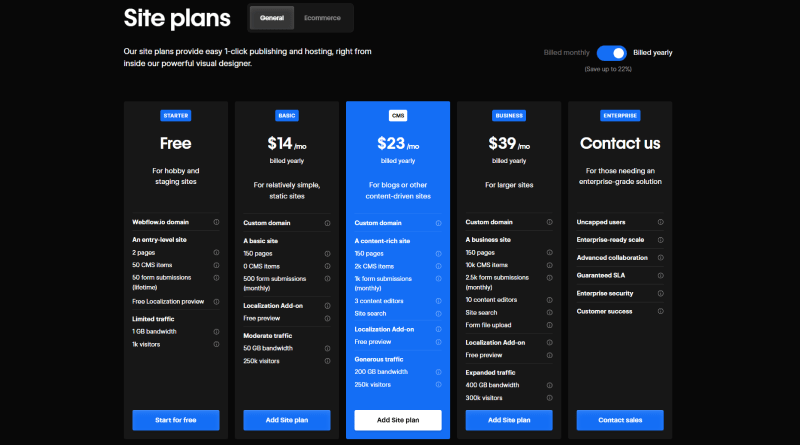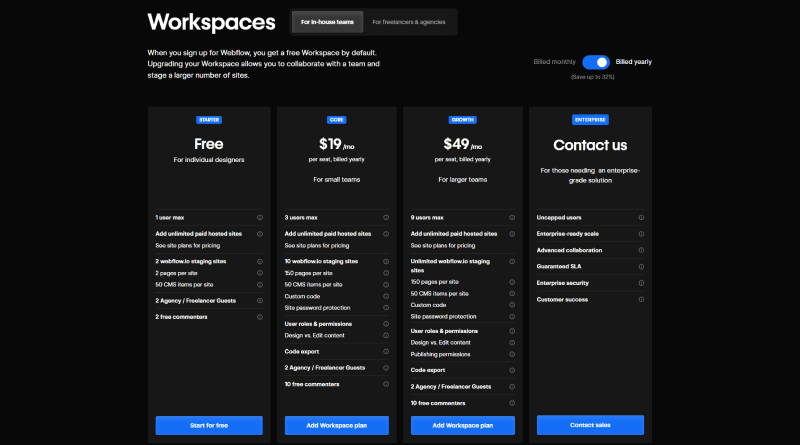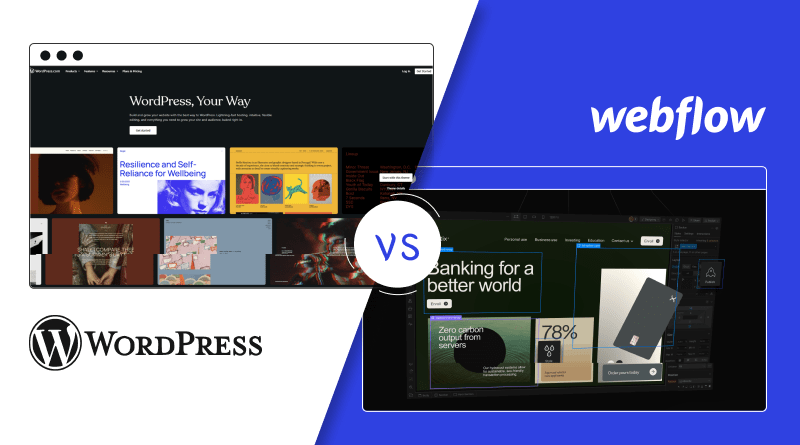Webflow and WordPress are both the most widely used website-building platforms. You can easily create simple or complicated websites without being an experienced website developer or programmer.
Businesses need to ensure that they’re utilizing one of the best website-building platforms that meet their unique requirements, and knowing your needs, objectives, and technical expertise is important when selecting website-building software.
Because your decision can affect your website’s performance, user experience, and work over the long term.
In this comprehensive guide, we’ll compare WordPress vs. Webflow to evaluate which platform is best for you to create a website. We’ll acquaint you with different aspects, from user-friendliness and customization to cost and technical support.
A Brief Look At WordPress Vs. Webflow
WordPress is undoubtedly the most commonly used website-building platform. It was originally launched as a blogging platform, but now powers more than 43% of all websites.
This open-source CMS platform offers nearly unlimited yet easy-to-customize themes and plugins.

Professional users can code to alter their websites using the file editor option. WordPress has gained recognition among website owners as an easy hosting platform for bloggers, website developers, and well-known businesses like TechCrunch, Bloomberg Professional, Sony Music, and Flickr.
For this comprehensive guide, we’re speaking of the .org version of WordPress instead of .com. Since the .com version is quite similar to Webflow for the reason that it’s a hosted platform. On the contrary, the .org is a self-hosted platform, i.e., you’re responsible for hosting your website.
And between WordPress .com and WordPress .org, WordPress.org is definitely the more powerful of the two, and it is a deserving competitor to Webflow. Also, in comparison with Webflow, WordPress requires additional work to arrange the whole thing because you’ve got complete control over the entire process. Including getting a domain name and a domain registrar, getting the right WordPress hosting platform, and all the required themes and plugins to build a website.
Webflow is an all-encompassing SaaS (Software-as-a-Service) platform for creating and hosting your website. Similar to other website-building platforms, Webflow can be a possible alternative to WordPress because of the speed and ease with which your website gets up and running.

You can develop websites by using its visual drag-and-drop website builder, which is basically useful for web designers searching for low-code or no-code tools to develop websites. But Webflow is so easy that anyone can use it to develop a website.
One of the significant variations between Webflow and other SaaS website-building platforms is that Webflow provides you access to your website’s basic code. Actually, the visual builder provides you with a visual tool to create your website’s HTML, CSS, and JavaScript.
All the functionalities are inherent, i.e., you don’t need to be bothered about looking for a host or installing additional plugins for stuff like SEO and eCommerce. Similar to WordPress, Webflow provides a CMS website option if you intend to create blog post website content, but it isn’t required for basic websites.
Just like other website creation platforms, one of the major drawbacks of Webflow is its capability to build your website without using code. In the case of WordPress, you’ll require a page builder such as Divi or Outshine, which has the built-in design abilities of Webflow.
WordPress vs Webflow: Comparison of Technology Stack
Both Webflow and WordPress have their benefits and drawbacks. Webflow is ideal for nonprofessional website builders who wish to have all their site management tools in a single location.
Even if WordPress is extremely customizable using plenty of plugins, you need to ensure that you’re keeping a record of these with timely updates. Since WordPress has been around for a long time, users can find lots of information about it on WordPress forums.
WordPress also has tons of themes and templates to be used for building your website. Whereas Webflow offers more design options along with a no-code web design interface to users.
| Technical Aspects | WordPress | Webflow |
| Monthly Costs | From $0 for WordPress.org up to $45 per month for WordPress.com | A free plan is also available Basic plan starts at $14/month CMS plan starts at $23/month Business plan starts at $39/month Enterprise plan: contact Webflow for pricing Ecommerce plans: 1. Standard plan start at $29/month 2. Plus plan starts at $74 per month 3. Advanced plan starts at $212 per month |
| Website Hosting | Need to purchase separately | Included |
| Site Editor | Visual or Code-based | Visual |
| SEO Tools | Multiple plugins are available. You can use them to make your website SEO-friendly. | Inbuilt SEO options are included with a Webflow subscription |
| Ecommerce | Free as well as paid plugins are available for e-commerce. WooCommerce is highly user-friendly and easy to use. | Webflow Ecommerce is still in beta for production stores. So, some of the important features are missing. It costs $29 per month at the very least. |
| Membership Websites | Available | Currently not available |
| Content Management | CMS functionality is available with all plans. | Not available on the very low-priced plan, you’re required to upgrade to the CMS plan, which costs $16 per month. |
| Customer Support | Live chat and 24*7 support on paid plans are available. | Available during normal business hours. An AI chatbot is also available for common issues. |
| Integrations | Thousands of plugins are available for analytics, SEO, Ecommerce, security, and much more. | The majority of features are already available with your subscription; a small number of integrations are available immediately, some of which you’ll need to improve. |
Web flow vs WordPress: Comparison of features
Webflow and WordPress provide whatever it is you need to develop a website, but you’re still required to depend on WordPress plugins for blogs to add certain features. These functionalities are indicated with an asterisk (*) in the following table:
Indeed, there are more diverse functional differences, which we’ll discuss in the coming sections below. But from the highest level, both Webflow and WordPress are capable in every aspect that the majority of website owners require.
| Features | WordPress | Webflow |
| Built-in Themes / Templates | ✔️ | ✔️ |
| Visual, Drag-and-drop design | ✔️* | ✔️ |
| Complete CMS (Content Management System) | ✔️ | ✔️ |
| Static HTML Websites | ✔️* | ✔️ |
| Blogging | ✔️ | ✔️ |
| Ecommerce | ✔️* | ✔️ |
| Full Code Access | ✔️ | ✔️ |
| SEO Optimization | ✔️* | ✔️ |
| SSL Certificates | ✔️ | ✔️ |
| Performance Optimization | ✔️* | ✔️ |
WordPress and Webflow: Ideal Users
WordPress is perfect for those users who would like to have complete control over their website’s functionalities and design. It is specifically suitable for those users who don’t have web development skills.
However, coding is not essential; still, WordPress can help you build your website. The blog posts and web pages are the core of the CMS platform, prioritizing content creation. Alternatively, web flow is built for those users who wish to have a more direct and streamlined approach towards creating a highly sophisticated website.
With Webflow, you will not be required to depend on a web developer or a graphic designer to receive a custom-made design for your website that is ultramodern. You can make use of in-built templates and a drag-and-drop visual design interface to build an elegant and responsive website instantly.
But if you want a highly intricate blog, WordPress might be the perfect option. In general, if your intention is total control and versatility, WordPress is good for you. Despite that, if you’re seeking a simple and code-free solution that permits customization, Webflow is worth trying.
WordPress vs. Webflow: Key Feature Differences
Concerning website building, it’s crucial to have an easy-to-use platform. Between the two, WordPress has a shorter learning period, particularly if you don’t have knowledge of HTML and CSS, but still, non-coders can utilize both.
But you should not avoid a website-building platform just for the sake of having a larger learning curve. Finding the perfect balance is necessary. The benefits of Webflow and WordPress over other platforms are that they make website building easier, even if you’re a non-developer.
To help you understand each platform’s ease of use, let’s delve deeper to find out what it’s like to develop a website using each platform.
Ease of Use
1. WordPress: Ease of Use
To launch your WordPress website, you’ll have to purchase a website hosting plan and install the WordPress software. Since WordPress is quite famous, the majority of hosting providers offer simple and easy software installer tools that allow you to install and set up the WordPress software with only a few clicks.
Once you install WordPress, you can control your website from the WordPress dashboard. When designing your website, you can use the best WordPress themes that fit your needs. Thus, you can effortlessly change your website’s appearance without losing any content when you install the theme.
If you’re looking for still more web design control, you can install a suitable WordPress plugin that provides drag-and-drop visual editing. Now, when it comes to creating content, like a blog post, you can make use of the WordPress block editor Gutenberg.
The editor utilizes a block-based system, which further simplifies the configuration of multi-column designs and integrates different elements like buttons. For more design control, you can continue to utilize the WordPress Elementor plugin or the page builder plugin.
For managing each aspect of your website, like website content, settings, users, comments, and so on, WordPress will provide dedicated screens through its dashboard. In general, you can build your website from scratch without using a single line of code.
Or else, if you’re a more professional user, you can still have complete access to your website’s fundamental HTML, CSS, PHP, and JavaScript.
2. Webflow: Ease of Use
Fortunately, the learning curve for Webflow is easy since it is spontaneous. To begin with the Webflow website, just register for a Webflow account. Once you sign up, Webflow will start a short survey to customize the website development experience according to your requirements.
After that, it starts with a guide to help you understand crucial concepts like containers and styling. Once you understand the basics, you can develop your own website. You can either begin from scratch or select an inbuilt template.
Begin developing your website with the help of Webflow’s visual, drag-and-drop editor. One of the most striking aspects of Webflow is that it provides total control over each element and style choice on your website.
If you want to add dynamic content to your website, like blog posts, you can use Webflow’s CMS feature. When using Webflow, you can start with a basic editor to integrate your blog post content.
You can seamlessly add images and videos, but the blog content editor isn’t as versatile as the WordPress block editor. For making your Webflow site live, you can opt for any two options:
- Pay Webflow to host your website. [You will be required to select this option if you’ve got a dynamic website that requires the Webflow CMS, for example, a blog or Ecommerce shop.]
- Export your website’s static code and host it elsewhere.
Themes and Templates
To assist you in creating a compelling website without necessitating designing it from scratch, both Webflow and WordPress allow you to use in-built designs for your website. In WordPress, these are called themes, whereas in Webflow, they’re referred to as templates.
Since WordPress is the most popular website builder, if you’re looking for more flexibility in finding an off-the-shelf design for your site, WordPress is the clear winner.
| WordPress | Webflow | |
| Free Themes or Templates | 12,000+ | 38+ |
| Premium Themes or Templates | 23,00+ | 2000+ |
Plugins and Extensions
Both Webflow and WordPress provide all the essential features required to create a website. If you wish to make a bigger website with features that go beyond those on the basic platform, usually most of the website building platforms facilitate this through extensions, even though the terminology varies.
These extensions can be referred to as “plugins,” “apps,” or “extensions.”
- WordPress
When using WordPress, you receive a huge collection of plugins that you can utilize to add functionalities to your website. For instance, the official WordPress.org plugins directory has around 59,000 free plugins.
You’ll also find thousands of premium plugins through other marketplaces or third-party developers. Additionally, WordPress presumes that you’ll utilize these plugins to improve your website’s functionality, including making your website responsive or increasing SEO.
- Webflow
Webflow website builder doesn’t offer official plugins similar to WordPress, i.e., you won’t be able to add extensions that directly operate inside the Webflow interface. But despite this, it doesn’t mean that you cannot grow your website with new functionalities. You can still increase Webflow by adding code snippets from another service.
For instance, if you expect to integrate live chat into your website, you can insert the JavaScript snippet from your ideal live chat service. For configuring a membership website using Webflow, you can add Memberstack.
But having said that, these integrations of code snippets can oftentimes feel like a workaround; on the other hand, WordPress plugins are completely inherent solutions.
Integrations With Third-Party Tools
To capitalize fully on your website, you might intend to have the ability to integrate with other tools that you’re utilizing, like CRM (Customer Relationship Manager), email marketing provider, and so on.
- WordPress
To integrate third-party services, WordPress outdoes other site-building solutions because you will get considerably more plugins for everything imaginable. If you require some more sophisticated integrations, you can find features such as WP Webhooks and Uncanny Automator that allow you to configure customized automation rules to integrate with other services.
Usually, the effortlessness with which you can integrate WordPress with third-party tools is indeed one of the most important benefits.
- Webflow
Webflow does not adequately support integrations. You can integrate your Webflow site with other tools, but you’ll receive very few native integrations compared to WordPress, which means you’ll need to rely on code embeds and separate interfaces in many situations.
E-commerce Functionality
Are you planning to develop an e-commerce website? Both Webflow and WordPress can assist you.
Using WordPress, you can integrate complete eCommerce functionality with the help of plugins like WooCommerce, which is almost certainly the most favored WordPress plugin for eCommerce. Actually, WooCommerce is the most common way to develop an eCommerce website overall, even knocking down dedicated eCommerce solutions.
With Webflow, the eCommerce functionalities are built into the core Webflow platform, considering you’re paying for the eCommerce plan.
Pricing
Now, let’s have a look at how much it will cost you to access all of those features discussed above:
Between the two platforms, WordPress has what it takes to be cheaper. In other words, if you’re searching for a completely inexpensive way to build a website, WordPress knocks out Webflow. But there are plenty of other features, like pricing, specifically for WordPress. Let’s go through them:
- WordPress Pricing
Basically, open-source WordPress is completely free. You can download, install, host, and control it all by yourself, but to say the least, it is accompanied by recurring costs that can accumulate quickly.
These recurring expenses include website hosting such as MilesWeb, domain name registration, theme and plugin licenses, and memberships. You’ll need to purchase a web hosting plan to run your WordPress website, which will incur expenses.
For a website with low traffic, you can get WordPress hosting for $1 to $10 per month. For instance, MilesWeb’s WordPress hosting starts at $1 per month. However, these costs are impractical for websites with high traffic since the majority of the hosting providers will be unable to keep up with the performance. For a heavy-traffic website, you’ll have to spend more money.
Purchasing a web hosting plan and domain name is the only compulsory cost of running a WordPress website. The aforementioned expenses can vary based on the website. For example, themes and plugin licenses can be recurring payments or lifetime subscriptions for a one-time cost.
Additionally, based on your website’s functionality and design requirements, you may want to pay for premium WordPress plugins and/or themes. A custom-made WordPress theme for a small business or personal website can cost between $1,500 and $5,000. On the other hand, a custom-made WordPress theme with additional features or companion plugins can cost anywhere between $6,000 and $10,000.
By and large, you can operate a simple WordPress website for $50 and $75 annually, but the actual cost would be $150 -$350 annually to provide for a few premium plugins and themes and possibly upgraded website hosting.
- Webflow Pricing
Websflow allows you to register, create an account, and start building your website for free, with no credit card needed. But having said that, you’ll have to sign up for a paid plan at the time of making your website live and available to visitors.
Webflow comes with two types of Plans:
- Site plans
You’ll need to sign up for a site plan for every website that you wish to host on Webflow’s platform.
Important note: You are not compelled to use Webflow’s web hosting services for static websites.
- Workspaces plans
You’ll require a workspace plan for more than two web projects. This paid plan allows several people to work on a website project with you. If you’re planning to host your websites on Webflow and also utilize its CMS, you’ll have to purchase a site plan for every website you wish to host.
If you want to use Webflow just for creating and designing websites, as well as hosting your website elsewhere and/or handing it over to customers, then you’ll require a Workspaces plan. In a few cases, you may be required to pay for both plans.
Webflow Site Plans
Webflow offers both general as well as Ecommerce site plans. The Starter site plan starts for free but can extend to $39 per month with yearly billing:

This being said, if you wish to create a blog or other content-driven website, you’ll require at the very least a CMS plan for $23 per month. Apart from these services, you might need a paid Webflow template, which usually costs between $49 and $79; however, some of them are priced lower or higher.
All in all, you can run a simple Webflow static website for $144 per year. However, the actual cost for dynamic features and premium templates is between $240 and $450.
Webflow Workspaces Plans
The free Webflow starter Workspaces plan allows you to host up to two web design projects, but you are not able to export code or move them to other Webflow accounts. The Webflow paid plans start at $19 per month for a maximum of 10 websites and exports or transfers:

Customization
When selecting the first website-building platform, it is hard to anticipate all the functionalities you may need down the line. Because of this, customization and versatility are crucial factors to determine when selecting a site-building solution.
Both Webflow and WordPress provide an extensive range of customization options but vary in their methods.
- WordPress Customization
WordPress is almost unlimited in terms of customization and versatility. This platform has all the tools, resources, and people required to build any website design. WordPress will beat most of the site builder platforms, together with Webflow.
The WordPress theme directory offers thousands of free themes for your website, and the premium themes and page builders can help you take design customization to another level! Besides themes, WordPress also comes with 50,000+ free plugins, which you can utilize to improve your website’s functionality in unlimited ways.
You can insert forms, social media integrations, eCommerce functionalities, email marketing, and so on with free as well as premium plugins. Additionally, those users who have coding knowledge can make WordPress their own by improving and modifying current themes with a few CSS tweaks or enhanced PHP coding.
All in all, WordPress provides unmatched customization options, which makes it an ideal choice for those users who are looking to build a truly one-of-a-kind website.
- Webflow Customization
With Webflow, you’ll get a wide range of free and paid templates that’ll assist you in kickstarting the website-building process. Despite that, changing templates/themes in Webflow isn’t as simple as changing a theme in WordPress.
If you wish to use a distinct Webflow template, you should build a new project and select another template. In other words, you’ll have to manually transfer data over or copy and paste different elements to a website on another Workspaces plan if you intend to get started with a new template.
Fortunately, changing those Webflow templates with unique designs and content is quite simple. Webflow provides 20+ design blocks or elements that you can use to personalize your website with the help of their visual builder.
These are comprised of everything, starting from simple text to Lottie animation elements. You can build “components” that work just like global block styling in WordPress, thereby modifying all instances of block content at a time.
Security
All websites are vulnerable to security threats, irrespective of the platform they’re on. The key is to find a platform that can provide the level of security that is needed for you.
- WordPress Security
As you know, WordPress is a widely used open-source software that is free to everyone. So, it is evident that WordPress might have security vulnerabilities that must be resolved. Since the majority of WordPress websites are based on third-party themes, plugins, and web hosting services, you’ll have to take extra safety measures to ensure that everything is protected from common WordPress attacks.
Also, the more complicated your website becomes, the more vulnerable it is to security threats. This might sound scary, but the reality is that you can get higher security with WordPress than you can with other website builders.
There are a great number of developers who are continuously working to make WordPress software safer. Using WordPress security tricks and other measures, you can make your website as safe as you want.
These plugins can assist you in tasks like monitoring activities, automated backups, malware scanning, safeguarding login pages, and so on. But sadly, as WordPress continues to stay popular, it’ll remain a target for attackers. Therefore, you must take its security seriously.
- Webflow Security
Webflow is commonly built on AWS (Amazon Web Services) hosting, an industry-leading highly secure web hosting service. Webflow has taken several extra security measures to protect information handling, customer data, payment processing, and much more.
It uses robust encryption across Websflow to secure data from unauthorized access. That means Webflow prioritizes security and does everything to secure your website from attackers. And the best thing is that you would not have to do anything.
The drawback is that you don’t have control over your website’s security and completely need to depend on Webflow.
WordPress vs. Webflow: Which website builder is perfect for your website? Both Webflow and WordPress are excellent website-building solutions for creating a website. Which one you select primarily depends on your requirements for a CMS.
For the majority of businesses and individuals planning to build a website, WordPress is a perfect choice because it’s highly flexible and easily integrates third-party tools. It can be cheaper and have a smaller learning curve if you aren’t already a developer.
In light of this, if you’re a developer or someone who can build lots of customer websites to generate income, you can choose Webflow because a number of its functionalities are targeted toward helping developers create websites quickly.
If you already know HTML/CSS but don’t have a deeper knowledge of coding, Webflow provides additional customization options. Eventually, it’s significant to note that you won’t always be required to select between Webflow and WordPress.
Using the official pages plugin of Webflow for WordPress, you can create pages for your WordPress website.
FAQs
Is Webflow better than WordPress for beginners?
WordPress vs. Webflow: Which website builder is right for you? It depends mainly on what your requirements are for a CMS. Webflow provides a visual design interface that streamlines website building without requiring deep coding skills. Which makes it ideal for newcomers. WordPress offers a wide range of resources and tutorials for newcomers as well as professionals looking to kickstart building their websites.
Is it easier to customize themes in WordPress compared to Webflow?
If you’re looking for wide-ranging customization options and are used to themes and plugins, or if you possess web development skills, WordPress provides higher flexibility and scalability.
WordPress vs. Webflow: Which platform is more cost-effective for hosting?
WordPress is a free and open-source website-building platform that can incur costs from hosting, themes, and plugins. Whereas a simple WordPress website can be inexpensive initially, the cost can increase with additional functionalities. On the other hand, Webflow offers a pricing model that includes hosting and its pricing can be predictable but might have higher upfront costs.
Does Webflow offer hosting services like WordPress?
Webflow provides free and different paid subscription options based on the functionalities and hosting services required.
Can I migrate my blog from WordPress to Webflow or vice versa?
Yes, definitely! You can migrate your blog from WordPress to Websflow or vice versa, but the process could be complicated and may require manual content transfer or third-party services for effortless transformation.















